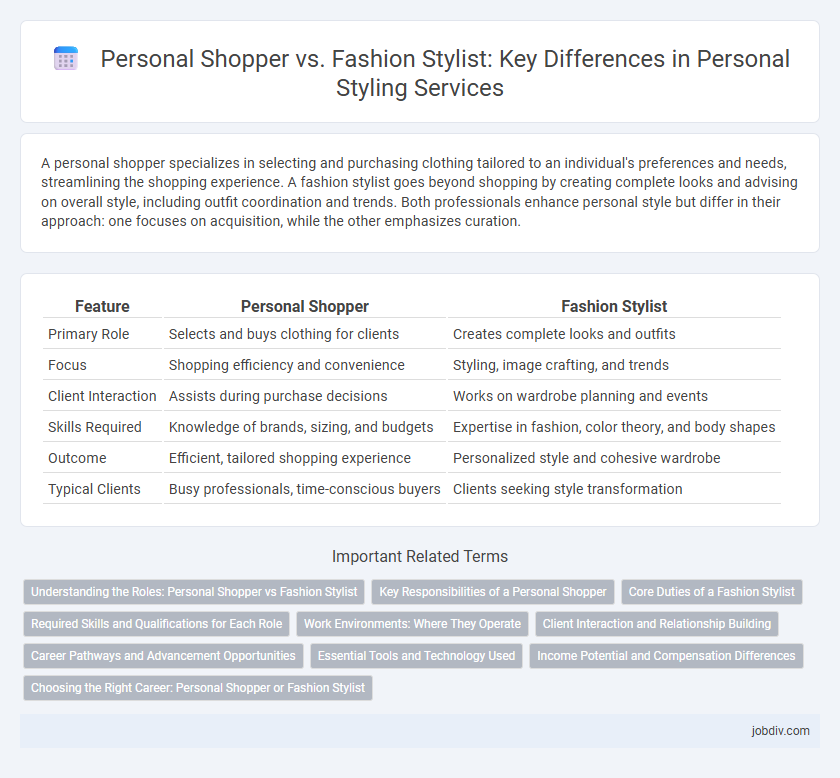A personal shopper specializes in selecting and purchasing clothing tailored to an individual's preferences and needs, streamlining the shopping experience. A fashion stylist goes beyond shopping by creating complete looks and advising on overall style, including outfit coordination and trends. Both professionals enhance personal style but differ in their approach: one focuses on acquisition, while the other emphasizes curation.
Table of Comparison
| Feature | Personal Shopper | Fashion Stylist |
|---|---|---|
| Primary Role | Selects and buys clothing for clients | Creates complete looks and outfits |
| Focus | Shopping efficiency and convenience | Styling, image crafting, and trends |
| Client Interaction | Assists during purchase decisions | Works on wardrobe planning and events |
| Skills Required | Knowledge of brands, sizing, and budgets | Expertise in fashion, color theory, and body shapes |
| Outcome | Efficient, tailored shopping experience | Personalized style and cohesive wardrobe |
| Typical Clients | Busy professionals, time-conscious buyers | Clients seeking style transformation |
Understanding the Roles: Personal Shopper vs Fashion Stylist
A Personal Shopper specializes in selecting and purchasing clothing or accessories tailored to a client's preferences and lifestyle, streamlining the shopping process. A Fashion Stylist curates complete looks for specific occasions, photo shoots, or public appearances, focusing on overall aesthetics and trends. Both roles enhance personal style but differ in their approach: one optimizes shopping efficiency, while the other crafts visual storytelling through fashion.
Key Responsibilities of a Personal Shopper
A personal shopper focuses on selecting and purchasing clothing and accessories tailored to an individual's style, fit, and budget, often working directly with clients to understand their preferences and needs. They research current trends, shop at various retailers, and provide personalized recommendations to enhance the client's wardrobe efficiently. Unlike fashion stylists who create entire looks for events or media, personal shoppers primarily handle the acquisition of fashion items, ensuring convenience and satisfaction in the shopping process.
Core Duties of a Fashion Stylist
A fashion stylist curates wardrobes by selecting clothing and accessories that align with clients' personal style, body shape, and occasion requirements. They collaborate closely with designers, photographers, and brands to create cohesive looks for photo shoots, events, or public appearances. Emphasis on trend forecasting, outfit coordination, and visual storytelling distinguishes their core role from that of a personal shopper.
Required Skills and Qualifications for Each Role
Personal shoppers require strong interpersonal skills, keen fashion sense, and the ability to personalize selections according to client preferences and budgets, often with experience in retail or customer service. Fashion stylists must possess advanced knowledge of fashion trends, excellent creativity, and expertise in coordinating outfits for various occasions, typically supported by formal training in fashion design or styling. Both roles benefit from effective communication, trend awareness, and a deep understanding of body types and color theory.
Work Environments: Where They Operate
Personal shoppers typically operate in retail environments such as department stores, boutiques, and shopping malls, directly assisting clients with purchasing decisions. Fashion stylists often work in diverse settings including photo shoots, fashion shows, advertising campaigns, and private client fittings, creating looks to suit specific themes or occasions. Both professionals may collaborate in studio spaces or clients' homes to provide personalized fashion services.
Client Interaction and Relationship Building
Personal shoppers emphasize personalized client interaction by understanding individual tastes and preferences to curate specific items that fit seamlessly into the client's lifestyle. Fashion stylists build deeper relationships by collaborating directly with clients or brands, offering broader wardrobe transformations and style guidance tailored to evolving fashion trends and personal goals. Both roles prioritize trust and communication, but personal shoppers focus on transactional efficiency while stylists invest in long-term style development and emotional connection.
Career Pathways and Advancement Opportunities
Personal shoppers often begin their careers in retail or customer service, gradually building expertise in client preferences and product knowledge, which can lead to roles in luxury retail management or private client services. Fashion stylists typically pursue formal education in fashion design or styling, advancing through internships and portfolio development toward opportunities in media, celebrity styling, or creative direction. Career advancement for personal shoppers leans toward personalized client management and brand consultancy, while fashion stylists frequently ascend to influential positions in fashion editorials, advertising campaigns, or wardrobe consulting for high-profile clients.
Essential Tools and Technology Used
Personal shoppers rely on mobile apps, client databases, and virtual closet software to streamline purchases and track preferences, ensuring efficient wardrobe updates. Fashion stylists utilize advanced fashion design software, mood boards, and 3D modeling tools to create cohesive looks tailored for photoshoots and events. Both professionals increasingly integrate AI-driven trend analysis and augmented reality (AR) fitting rooms to enhance client experience and accuracy.
Income Potential and Compensation Differences
Personal shoppers typically earn an hourly wage or commission based on the sales they generate, with average incomes ranging from $30,000 to $60,000 annually; fashion stylists, however, command higher fees due to their specialized expertise, often earning between $50,000 and $100,000 or more per year through client fees and brand collaborations. Income potential for fashion stylists is boosted by opportunities in media, advertisements, and celebrity endorsements, whereas personal shoppers primarily rely on retail commissions and client retainers. Compensation differences reflect the stylist's broader creative role and industry connections, leading to more variable but often higher earnings compared to the more transactional nature of personal shopping.
Choosing the Right Career: Personal Shopper or Fashion Stylist
Choosing the right career between a personal shopper and a fashion stylist depends on your passion for direct client interaction and fashion curation. Personal shoppers prioritize assisting clients with purchasing decisions, focusing on individual needs and budget, while fashion stylists emphasize creating cohesive looks for clients in media, events, or personal wardrobes. Understanding these distinct roles helps tailor your career path to suit your skills and professional goals in the fashion industry.
Personal Shopper vs Fashion Stylist Infographic

 jobdiv.com
jobdiv.com